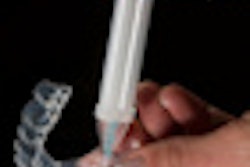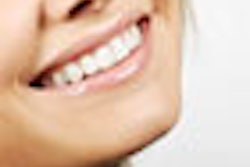
A new study has pitted an experimental 9.5% H2O2 whitening strip against a 10% H2O2 strip to see which one was more effective. The researchers from the University of Louisville School of Dentistry and other universities have definitive results in their study published in the Journal of Dentistry (article in press; uncorrected proof published online December 10, 2012).
The two-hour regiment for the 9.5% H2O2 high-adhesion whitening strip (the experimental strip) was more efficient for teeth whitening than the 30-minute regimen of the 10% H2O2 whitening strip (Crest Whitestrips Premium), according to the researchers.
Both whitening strips were determined to be without adverse side effects in the randomized, blinded parallel group, single-center clinical trial.
“If you leave the strips in place for an extended period of time, you will see better results.”
"I believe that the main point is related with the wear time of the strips," lead author Gustavo Oliveira, DDS, MS, an assistant professor in the department of general dentistry and oral medicine at the University of Louisville School of Dentistry, told DrBicuspid.com. "If you leave the strips in place for an extended period of time -- in this particular case -- you will see better results. Another point is that the strips are an honest and reliable treatment option whenever the indications are met."
According to previous studies, "the quality of contact between bleaching agent and tooth structure is of cardinal importance," Dr. Oliveira and his co-authors noted. The researchers learned of a new strip technology created by Crest and wanted to learn how it would compare to a brand currently on the market. They described the "improved platform" as a "novel, proprietary polymer-based adhesive matrix with optimized adhesive and cohesive properties" and tested its effectiveness and safety.
No adverse side effects
The experimental and control strips were tested over a nine-day period at the University of North Carolina at Chapel Hill. Volunteers for the study responded to advertisements seeking participants that were interested in teeth whitening. Selected participants, 29 in all, had a tooth shade of A2 or darker using Vita's Vitapan Classical shade guide.
They were tracked for five visits, during which the researchers performed a baseline evaluation, distributed materials, and treatment performance evaluations at the third, fifth, and ninth day. Each was randomly assigned to the experimental or control group.
The experimental group used the 9.5% hydrogen peroxide gel whitening strips daily for two hours, and the control group used the 10% hydrogen peroxide gel treatments daily for 30 minutes. After distribution, the participants applied their respective treatments unsupervised. Upon completion, their whitening progress was measured with digital image analysis.
The results were quite positive for both treatment options, yielding significant improvement (p < 0.02) of b and L tooth color parameters relative to baseline as early as the day 3 study visit, the researchers noted, although the 9.5% H2O2 applied for two hours outperformed the treatment of 10% for 30 minutes at this point. These results were consistent through to the final day of the study.
Overall, the two-hour strip group demonstrated statistically greater yellowness reduction and lightness improvement relative to the 30-minute strip group at each postbaseline assessment (p < 0.02), the researchers wrote.
There were no severe adverse side effects, although half of the participants experienced oral symptoms during the study: 29% of the two-hour group and 13% of the 30-minute group reported tooth sensitivity. Oral irritation was reported by 21% of the two-hour group and 40% of the 30-minute group.
"If you reduce the concentration and extend the duration of the treatment, the results tend to be good as well and associated with milder side effects," Dr. Oliveira acknowledged.
Overall, the results were in line with the researchers' expectations. "It is scientifically accepted that bleaching is a factor between the concentration of the bleaching agent (either hydrogen peroxide or carbide peroxide) in contact with the tooth structure and the duration of the treatment," Dr. Oliveira stated. "If the concentration is higher, it may produce faster results that are generally associated with higher incidence of side effects."
Given the results, could the 30-minute treatment option simply be applied longer for better results?
"Possibly," Dr. Oliveira allowed. "The logic would be the same, especially if the only difference between each system was the concentration of the bleaching agent. It is important to remember that, in our study, the differences in the composition of the whitening gel, the amount of gel in each strip system, and the differences in the strip adhesion to the teeth were not disclosed by the manufacturer."
Dr. Oliveira noted that his comments reflect his personal points of view and do not correspond directly or indirectly to the views of the University of Louisville.



















